X
This article was co-authored by wikiHow Staff. Our trained team of editors and researchers validate articles for accuracy and comprehensiveness. wikiHow's Content Management Team carefully monitors the work from our editorial staff to ensure that each article is backed by trusted research and meets our high quality standards.
This article has been viewed 31,982 times.
Learn more...
Whether you're going on a hiking trip or carrying heavy books from school, a good backpack can be your best friend. Sometimes, you might waste your money on buying bad ones that wear out quickly. Buy a quality backpack and don't throw hard-earned money down the drain.
Steps
Method 1
Method 1 of 3:
Buying a Backpack for Hiking and Camping
-
1Pick the right size. Whereas school backpacks come in standard sizes, hiking bags have a wide range to choose from. Think about whether you need your backpack for one day, a weekend or a full-fledged trek across mountainous terrain.
- A day-pack will hold things like lunch, camera, sweatshirt and first-aid kit. They are no more than 2500 cubic inches or 40 liters.[1]
- Weekend backpacks can hold more things like a small tent, sleeping bag and sets of clothes. They are 2500 to 3999 cubic inches or 40 to 65 liters.
- Expedition backpacks are for the serious explorer and can be over 6000 cubic inches or 95 liters. They will hold all your gear on hikes that last longer than a weekend and containers that keep food from bears.
-
2Find the right fit. Hiking for long periods makes the fit of a backpack that much more important. Find a friend or salesperson to help measure your torso. Hiking backpacks come in different lengths regardless of how many things they fit. Consider packs designed for your frame.
- The length of your torso is measured from the base of your neck to the small of your back.
- Women's packs have narrower shoulder straps and customized hip belts.[2]
Advertisement -
3Decide on the type of frame. Depending on your needs, you will want to choose the appropriate frame. Day-packs are frame-less, while longer hikes require either internal or external frames.
- External frame packs offer more stability, but are not as adjustable as internal frames.
- External frames are good when hiking in open areas and when heat is an issue, because they offer more ventilation.
- Internal frame packs are more form-fitting and can work better in tight spaces.
- Internal frames help you move around easier than external ones and are good for skydiving or mountain climbing.
-
4Inspect the straps. The right shoulder straps are important, but hiking packs have a variety of choices. Look at whether the pack offers compression, sternum and waist straps.The right ones can help stabilize weight, fit better and keep you on the trail longer.
- Find padded shoulder straps. If not completely padded, the pads should lay one to two inches below the high point of your shoulders.
- Consider compression straps, if you want a versatile size. These straps will prevent your bag from flopping around when not completely filled.
- Sternum straps should be used if you need extra stability for carrying large loads.
- Any hike longer than a half day should use waist straps (hip belt). These will distribute the weight of your bag evenly and prevent a sore back. They can be padded for extra cushioning.
-
5Keep quality in mind. Hiking can require spending hours in the wilderness. Make sure the craftsmanship of your bag is on point and free of loose threads, raw fabric edges or uneven stitching.
- Zippers should have a covering for fabric.
- Weight matters. Look for packs no more than three pounds for long hikes.
-
6Ventilate yourself on the trail. Hiking can be long and vigorous. You don't want to get sweatier than you have to by using fabric that doesn't breath. Look for mesh backing and foam shoulders.
Advertisement
Method 2
Method 2 of 3:
Customizing Your Hiking Pack with Extras
-
1Hydrate quickly with a hydration sleeve. Many packs offer a hydration pouch system, which is a designated reservoir for water built into the pack. You can easily grab the sleeve when you get thirsty.[3]
-
2Think about how you need to access the pack. Many packs designed for long hikes are top-loading. This is good for unloading a campsite. Other activities may require easier access to lunch or cameras. Some will offer side zippers to easily get to the main compartment.
-
3Consider pockets to make your hike easier. Multi-sized pockets on the outside and inside of your pack will make it easier to grab a protein bar, or camera to take that rare bird photo. Look for small pockets for your cellphone or GPS.[4]
- Elasticized side pockets stretch to hold medium sized objects like tent poles or water bottles.
- Hip-belt pockets are great for small items you want to get to quickly.
- Shovel pockets can be used for larger items like a cover-up or what it was originally intended for - a snow shovel.
-
4Weatherproof your pack. External frames have outside attachments for things like sleeping bags. Find a thick, rain resistant covering for your sleeping bag. If you want extra protection, consider a cover for your entire bag. It will prevent rain from seeping through zippers.
-
5Think about a sleeping bag compartment. Some packs have a large pocket at the bottom suited perfectly for a sleeping bag. If you don't want to put a sleeping bag there, it's a good spot for jackets, clothes or blankets.
-
6Decide on removable pieces. If you want a removable day-pack for when you get to the campsite, look for multi-unit backpacks. Some of these can detach from the larger pack and be used around your waist for a quick hike up a small peak.
Advertisement
Method 3
Method 3 of 3:
Buying a Backpack for School or Travel
-
1Consider day to day comfort. Look for backpacks that will be the right size for your daily needs. Using an overly large backpack will make it more likely you will overfill it.[5] Think about how many books or electronics you need to carry.
- Don't try to carry more than 15% of your body weight.
- Rolling backpacks can be a great alternative if you have heavy loads.
-
2Find the right fit. Look for padded shoulders and try backpacks on. Two strapped bags are better than single strapped, because they distribute weight better. Try backpacks on, if not shopping online and remember the bottom should rest on the curve of your lower back.
-
3Keep quality in mind. Loose threads and careless stitching can be dead giveaways of bad quality. A backpack can give years of good use and you want to make sure your investment is durable. Inspect the fabric for any raw edges.
-
4Think about extra features. Backpacks come in all types and extra features can be either useful or unnecessary. If you carry a lot of small items such as pencils, keys or snacks, you may want extra pockets to easily access them. Some bags have padded pockets for computer tablets and laptops. Opt for a more basic backpack, if you don't need these extra compartments.
-
5Choose the right style. Think about where you will be taking your new backpack. If you are going off to college, you may want a bag that will carry heavy books, but also show some personal style. If you're traveling in urban areas, you will want a streamlined, modern style.[6] These bags typically have hidden pockets that do not look bulky.
Advertisement
Community Q&A
-
QuestionI am trying to find a backpack for 7th grade. I found a good backpack online, but I found another that I also like. I don't know what to do. Any suggestions?
 MymyCommunity AnswerDetermine which one’s design or colors you like best. If you can’t choose which one you like best, look at the price of the backpacks. Choose the cheapest one so you don’t have to spend more money. If they’re the same price, look at the sturdiest one. Find out which one is the strongest and the one you’ll have the longest. If they’re exactly the same in every way, just choose one!
MymyCommunity AnswerDetermine which one’s design or colors you like best. If you can’t choose which one you like best, look at the price of the backpacks. Choose the cheapest one so you don’t have to spend more money. If they’re the same price, look at the sturdiest one. Find out which one is the strongest and the one you’ll have the longest. If they’re exactly the same in every way, just choose one! -
QuestionI'm looking for a waterproof backpack for work that will stay upright. Any suggestions?
 K MatsoCommunity AnswerTry a good quality backpack brand, such as Superdry. I personally have their camouflage one with patches and it's perfect.
K MatsoCommunity AnswerTry a good quality backpack brand, such as Superdry. I personally have their camouflage one with patches and it's perfect.
Advertisement
Warnings
- Carrying more than 10-20% of your body weight in a backpack can cause back pain, poor posture, and numbness in your arms or hands.⧼thumbs_response⧽
Advertisement
References
- ↑ http://www.backpacker.com/gear/backpack-buying-guide
- ↑ http://boyslife.org/outdoors/guygear/8296/backpack-buying-guide/
- ↑ https://www.theadventurejunkies.com/best-day-hiking-backpack/
- ↑ https://www.rei.com/learn/expert-advice/backpack.html
- ↑ http://www.consumerreports.org/cro/backpacks/buying-guide
- ↑ https://thesavvybackpacker.com/travel-backpack/
About This Article
Advertisement
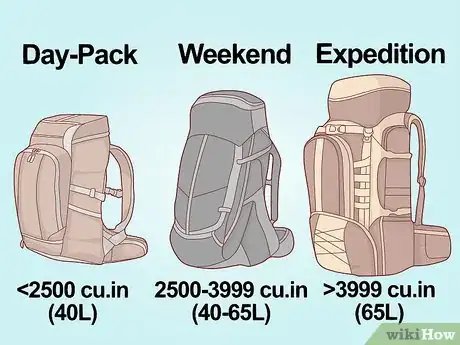
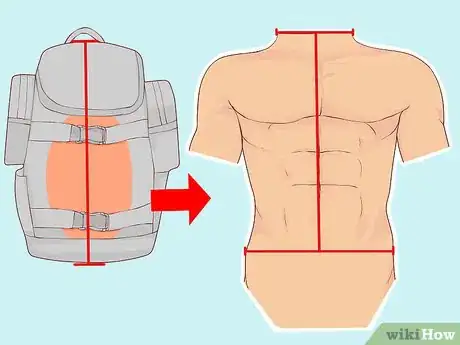
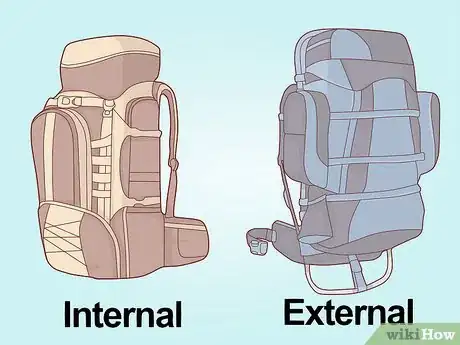
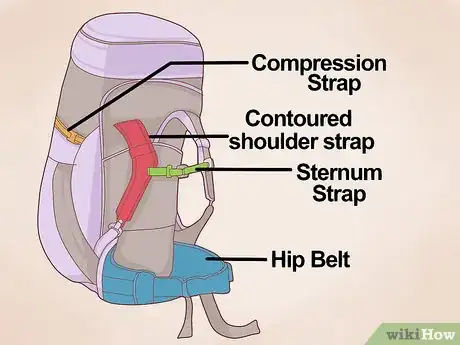

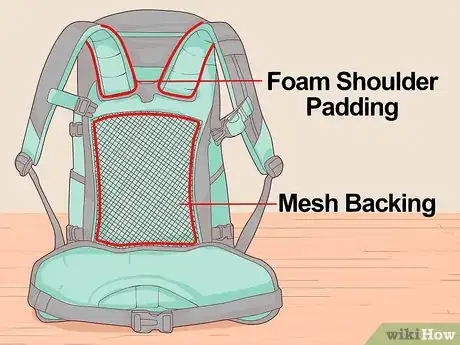



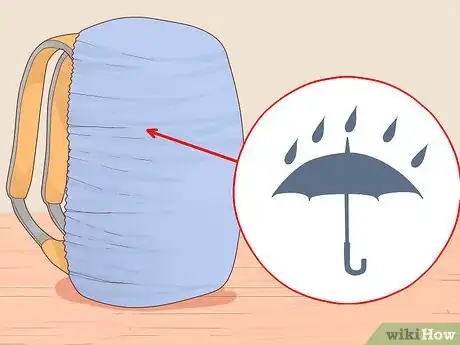




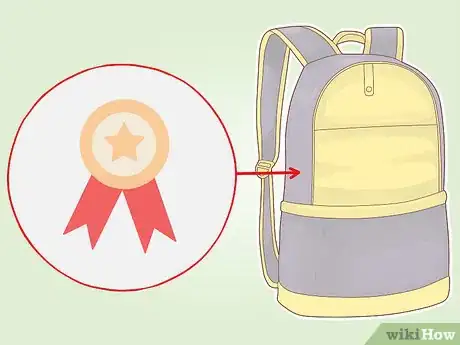





-Step-8.webp)








-Step-8.webp)

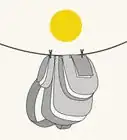


-Step-8.webp)



































